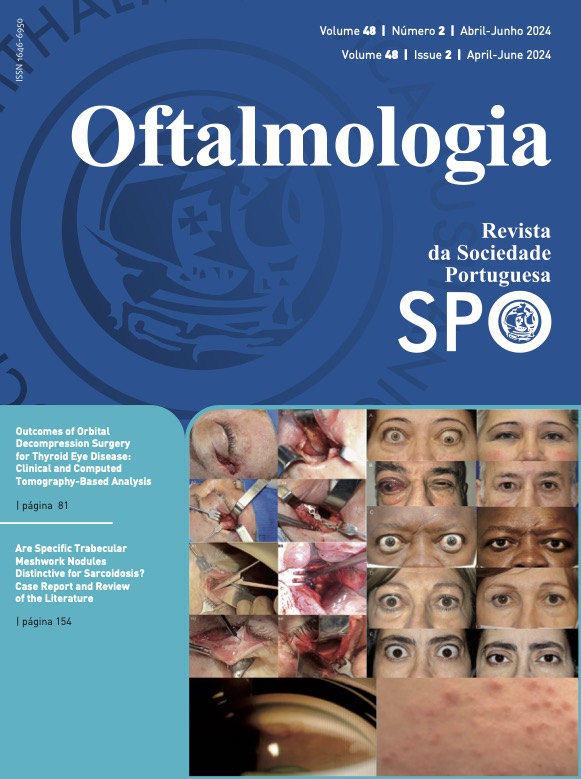Quality and Readability of Online Information on Keratoconus in Portugal
DOI:
https://doi.org/10.48560/rspo.28289Keywords:
Comprehension, Consumer Health Information, Information Sources, Internet, Keratoconus/therapy, ReadingAbstract
INTRODUCTION: Keratoconus is the most common primary corneal ectasia. Nowadays, patients try to look on the Internet for answers to their expectations in diagnosis, treatment and prognosis. However, the webpages are not filtered or submitted to evaluation and quality control before getting published. We aim to evaluate the quality and readability of the online information available for the patients regarding keratoconus.METHODS: Two independent ophthalmologists and one ophthalmologist supervisor evaluated 31 websites from a Google search by order of appearance with the word “Queratocone”, using 2 quality scores: a quality index of consumer health information (DISCERN) and the Journal of the American Medical Association (JAMA) benchmark, as well as the presence of a quality seal. We also evaluated the readability, using 3 readability scores: FleschKincaid Reading Ease (FRE), FleschKincaid Grade (FKG) and Automated Readability Index (ARI).
RESULTS: We obtained 12 sites (38.70%) from private hospitals or clinics, 5 (16.13%) from online health platforms, 4 (12.90%) from spectacles/contact lenses companies, etc. The average score for each JAMA benchmark item was: 1: 0.48±0.51, 2: 0.32±0.48, 3: 0.03±0.18 and 4: 0.42±0.50; the average final score was: 1.26±1.24. The average score for each DISCERN section was: 1: 17.42±7.56, 2: 15.68±5.68 and 3: 2.45±1.21; the average final score was 35.55±13.63. The mean FRE score was 32.23±12.98, which corresponds to “difficult to read” and to college school level, as well as a concordant mean FKG of 14.72±3.24; the mean ARI was 14.81±4.09, which denotes “professor” level needed to understand the text. Eleven sites (35.48%) exhibited some kind of quality seal and did not show statistically significant better readability or quality scores than sites without quality seal. There was no apparent strong correlation between google ranking and quality and readability scores.
CONCLUSION: The information on keratoconus that is available online to Portuguese speaking patients is, overall, of poor quality and difficult to interpret. Physicians need to be aware that some patients might fully trust their own online research. Ophthalmologists have a shared responsibility to tackle this challenge through multifold efforts, cooperating with different entities and resources to improve the information that is available online and educating our patients on how to find reputable web sites that can help them navigate their life with keratoconus.
Downloads
References
Volatier TLA, Figueiredo FC, Connon CJ. Keratoconus at a Molecular Level: A Review. Anatomical Record. 2020;303(6):1680-1688. doi:10.1002/ar.24090
Santodomingo-Rubido J, Carracedo G, Suzaki A, Villa-Collar C, Vincent SJ, Wolffsohn JS. Keratoconus: An updated review. Contact Lens and Anterior Eye. 2022;45(3). doi:10.1016/j. clae.2021.101559
Hashemi H, Heydarian S, Hooshmand E, et al. The Prevalence and Risk Factors for Keratoconus: A Systematic Review and Meta-Analysis.; 2019. www.corneajrnl.com
Peña-García P, Sanz-Díez P, Durán-García ML. Keratoconus Management Guidelines. Int J Keratoconus Ectatic Corneal Dis. 2015;4(1):1-39. doi:10.5005/jp-journals-10025-1095
Gordon-Shaag A, Millodot M, Shneor E. The Epidemiology and Etiology of Keratoconus. Int J Keratoconus Ectatic Corneal Dis. 2012;1(1):7-15. doi:10.5005/jp-journals-10025-1002
Atalay E, Özalp O, Yıldırım N. Advances in the diagnosis and treatment of keratoconus. Ther Adv Ophthalmol. 2021;13:251584142110127. doi:10.1177/25158414211012796
Powell JA, Mfphm M, Darvell M, Gray JAM, Frcp D. The Doctor, the Patient and the World-Wide Web: How the Internet Is Changing Healthcare. Vol 96.; 2003. www.naus.jc
Jesse Panthagani J, Hamze H, Riaz A, Moussa G. Evaluating the quality and readability of online information on keratoconus treatment. Can J Ophthalmol. 2021 Oct 20;S0008-4182(21)00351-3. doi: 10.1016/j.jcjo.2021.09.006.
Jia X, Pang Y, Liu LS. Online health information seeking behavior: A systematic review. Healthcare (Switzerland). 2021;9(12). doi:10.3390/healthcare9121740
Hone T, Palladino R, Filippidis FT. Association of searching for health-related information online with self-rated health in the European Union. Eur J Public Health. 2016;26(5):748-753. doi:10.1093/eurpub/ckw022
LaValley SA, Kiviniemi MT, Gage-Bouchard EA. Where people look for online health information. Health Info Libr J. 2017;34(2):146-155. doi:10.1111/hir.12143
Panthagani J, Hamze H, Riaz A, Moussa G. Evaluating the quality and readability of online information on keratoconus treatment. Canadian Journal of Ophthalmology. Published online 2021. doi:10.1016/j.jcjo.2021.09.006
Mack J, Silberg George D Lundberg WM, Musacchio RA. Public Hearings, Food and Drug Administration and the Internet, Advertising and Promotion of Medical Products. Vol 62. Addison-Wesley Publishing Co; 1997. http://www.fda.gov/ opacom/morechoices/transcript1096/fdainet.html
Charnock D, Shepperd S, Needham G, Gann R. DISCERN: An instrument for judging the quality of written consumer health information on treatment choices. J Epidemiol Community Health (1978). 1999;53(2):105-111. doi:10.1136/jech.53.2.105
Matheson GJ, Bjo ̈bjo ̈rn B, Schiffler C, Thompson WH. The readability of scientific texts is decreasing over time PONTUS PLAVÉ N-SIGRAY. doi:10.7554/eLife.27725.001
Keinki C, Zowalla R, Pobiruchin M, Huebner J, Wiesner M. Computer-Based Readability Testing of Information Booklets for German Cancer Patients. Journal of Cancer Education. 2019;34(4):696-704. doi:10.1007/s13187-018-1358-0
Flesch R, Ferry D. A New Readability Yardstick *. Vol 32.; 1948.
Peter Kincaid Robert Fishburne Jr Richard L Rogers Brad S Chissom JP. Derivation Of New Readability Formulas (Automated Readability Index, Fog Count And Flesch Reading Ease Formula) For Navy Enlisted Personnel. http://library.ucf.edu
Smith EA, Senter ’ R 1. AUTOMATED READABILITY INDEX
Kher A, Johnson S, Griffith R. Readability Assessment of Online Patient Education Material on Congestive Heart Failure. Adv Prev Med. 2017;2017:1-8. doi:10.1155/2017/9780317
Weiss BD, Schwartzberg JG, Davis TC, Parker RM, Williams M v, Wang CC. Health Literacy A Manual for Clinicians With Contributions From.
Downloads
Published
How to Cite
Issue
Section
License
Copyright (c) 2024 Revista Sociedade Portuguesa de Oftalmologia

This work is licensed under a Creative Commons Attribution-NonCommercial 4.0 International License.
Do not forget to download the Authorship responsibility statement/Authorization for Publication and Conflict of Interest.
The article can only be submitted with these two documents.
To obtain the Authorship responsibility statement/Authorization for Publication file, click here.
To obtain the Conflict of Interest file (ICMJE template), click here





